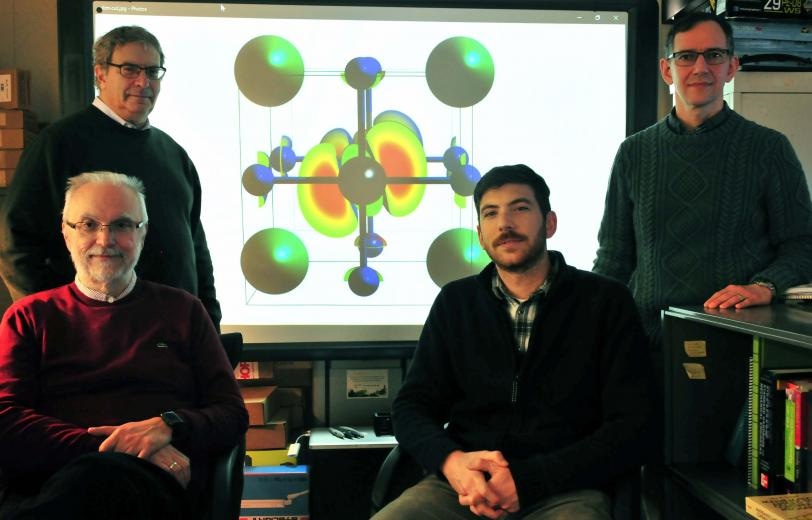Feb 1 2018
A team of researchers at the U.S. Naval Research Laboratory (NRL) Center for Computational Materials Science, partnering with an international team of physicists, have exposed that nanocrystals made of cesium lead halide perovskites (CsPbX3) is the first discovered material where the ground exciton state is "bright”; making it an interesting option for more efficient light emitting diodes (LEDs) and solid-state lasers.
 Researchers at the U.S. Naval Research Laboratory Center for Computational Materials Science, working with an international team of physicists, show that cesium lead halide perovskites nanocrystals (CsPbX3) — which atomic structure is shown on rear screen — emit light much faster than conventional light emitting materials. Pictured standing (l-r) are NRL researchers Dr. Alex Efros and Dr. Noam Bernstein; sitting (l-r) are Dr. John Michopoulos and Dr. John Lyons. (Image credit: U.S. Naval Research Laboratory/James Marshall)
Researchers at the U.S. Naval Research Laboratory Center for Computational Materials Science, working with an international team of physicists, show that cesium lead halide perovskites nanocrystals (CsPbX3) — which atomic structure is shown on rear screen — emit light much faster than conventional light emitting materials. Pictured standing (l-r) are NRL researchers Dr. Alex Efros and Dr. Noam Bernstein; sitting (l-r) are Dr. John Michopoulos and Dr. John Lyons. (Image credit: U.S. Naval Research Laboratory/James Marshall)
The discovery of such material, and understanding of the nature of the existence of the ground bright exciton, open the way for the discovery of other semiconductor structures with bright ground excitons. An optically active bright exciton in this material emits light much faster than in conventional light emitting materials and enables larger power, lower energy use, and faster switching for communication and sensors.
Dr. Alexander Efros, Research Physicist - NRL
The research, which was partly sponsored by the Office of Naval Research through a program run by Dr. Chagaan Baatar, examined lead halide perovskites with three different compositions, including bromine, chlorine and iodine. Nanocrystals made of these compounds and their alloys can be adjusted to emit light at wavelengths that span the whole visible range while retaining the fast light emission that offers them their higher performance.
Semiconductors discharge light when bound pairs of electrons and holes, called excitons, recombine in a process known as radiative decay.
In all known semiconductors and semiconductor nanostructures, the lowest energy state for a bound electron-hole pair is a ‘dark’ state. This means the material emits light slowly and weakly.
Dr. Alexander Efros, Research Physicist - NRL
As in perovskite nanocrystals, the lowest energy exciton is bright and the time it takes for the electron and hole to rejoin and create light, known as their radiative lifetime, is 20 times quicker than conventional materials at room temperature and 1000 times quicker at cryogenic temperatures.
It is common knowledge, that quantum-dot based LEDs (QLEDs), can suffer from “droop,” or decreased efficiency, at high pumping intensity because of processes that dissipate the energy of excitons before they have time to release light. The reduced radiative lifetime should make it probable for LEDs based on these perovskites to apply all of the energy input to produce light before it is dissipated through slower processes.
The increased rate of light emission of these materials holds great promise for various technological applications that rely on LEDs and lasers. In principle, the 20 times shorter lifetime could, therefore, lead to 20 times more intense LEDs and lasers.
Dr. Alexander Efros, Research Physicist - NRL
The power of a laser relies on the gain of the material it is made of, and this gain is relative to the radiative emission rate.
Communication in free space using visible light renders it possible to convey information in tight beams for long distances without copper cables or fiber optic cables. This would also profit from the increased light emission rates. “The maximum bandwidth of the communication system is limited by the rate at which the LEDs can turn on and off, and the shorter radiative lifetime translates directly into faster switching and therefore a higher data transmission rate,” says Efros.
The success of this research was because of a close collaboration between many experimental groups in Zurich, Switzerland and U.S. theoreticians.